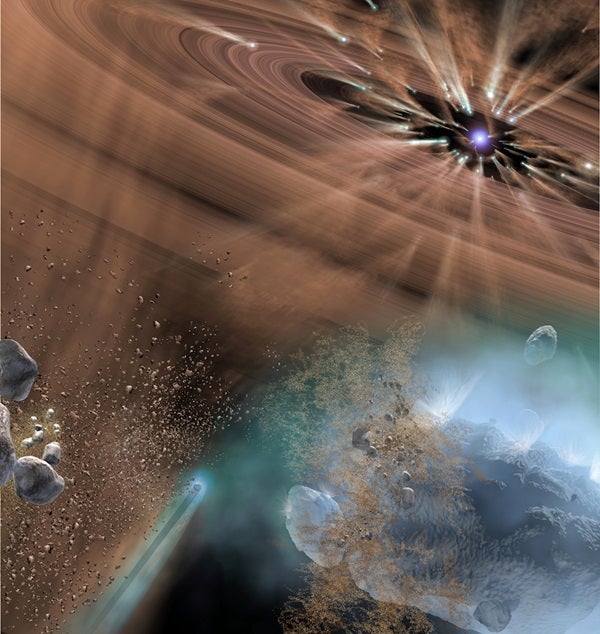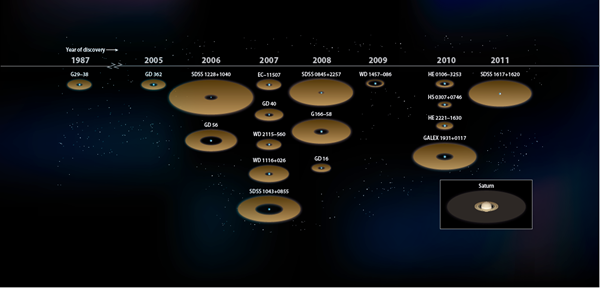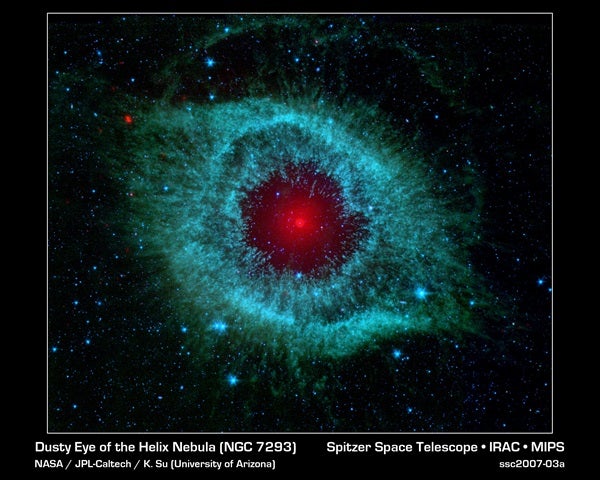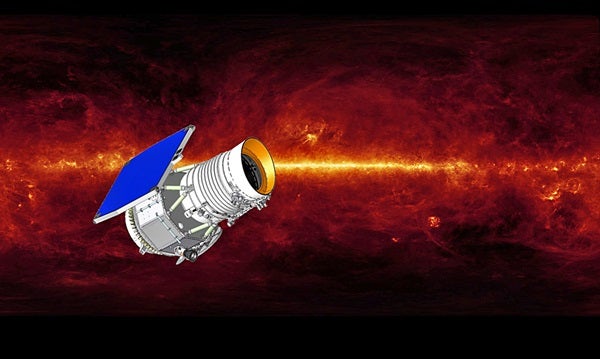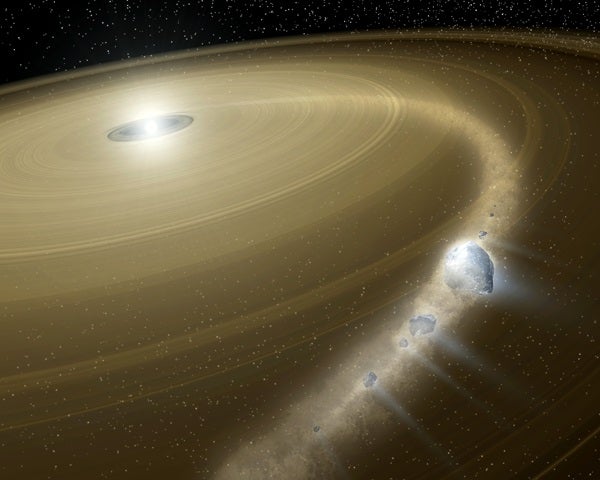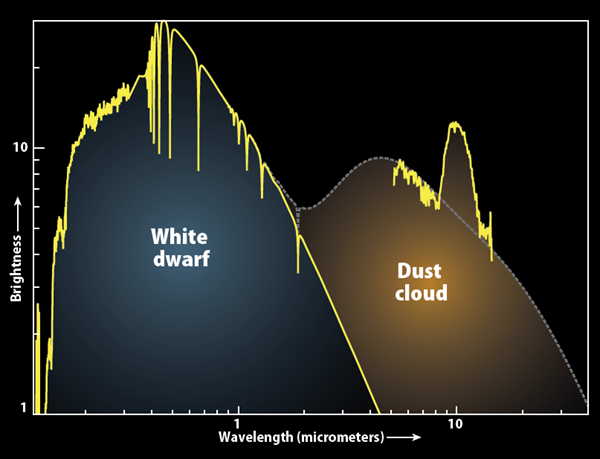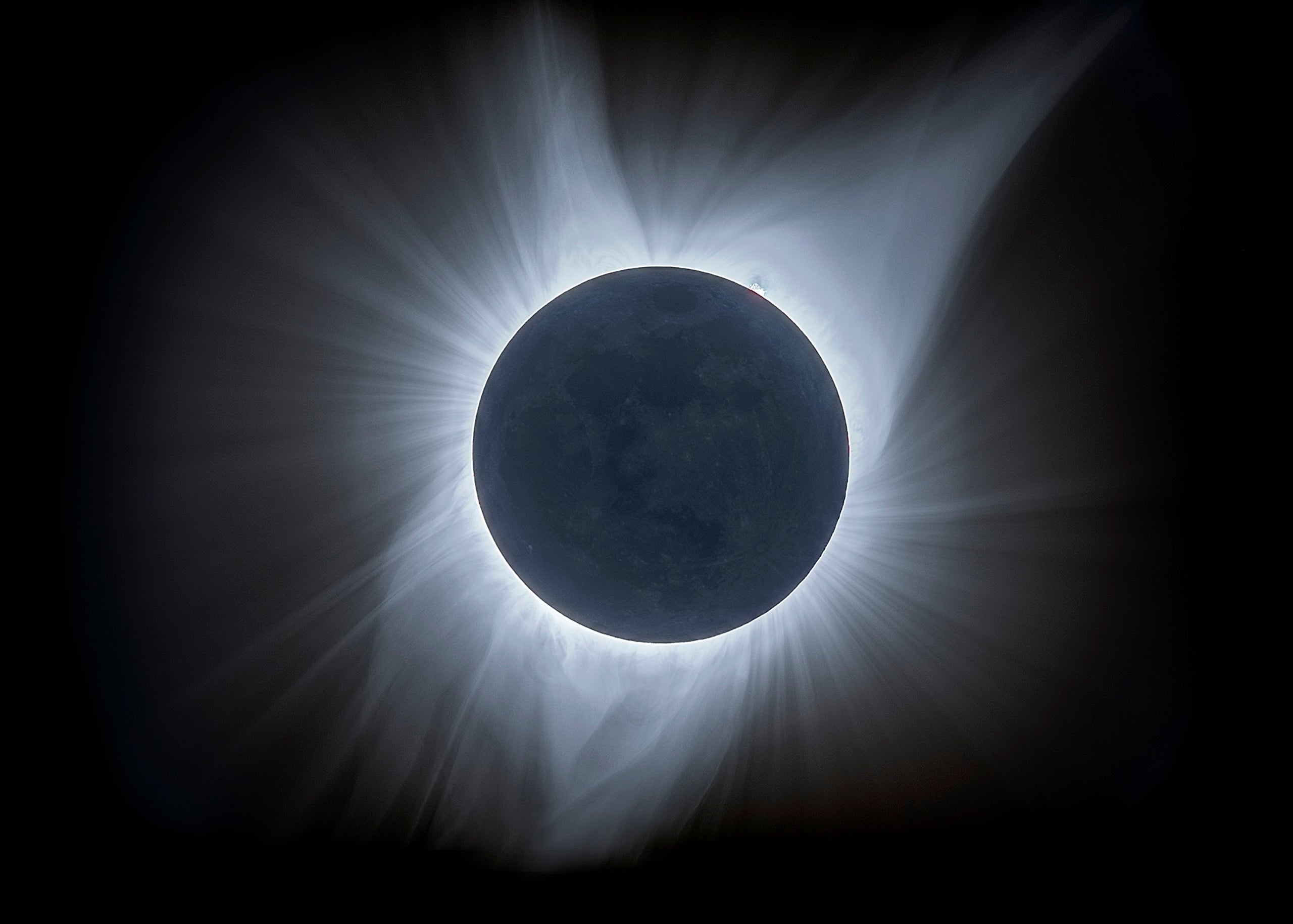This article originally appeared in our March 2012 issue.
A low cloud deck hung over the launch complex at California’s Vandenberg Air Force Base December 14, 2009. The predawn darkness exploded with light as a Delta II rocket ignited. Its cargo: NASA’s Wide-Field Infrared Survey Explorer (WISE) space telescope. The rocket quickly broke through the clouds, a fitting metaphor for the telescope, whose infrared vision could penetrate clouds of dust to reveal heat sources beyond.
One of WISE’s main goals was to help scientists understand our galaxy’s youth and the birth of the solar system — and possibly to tell the tale of how it all began. The telescope surveyed the entire sky during its 10-month mission. It discovered nearby brown dwarfs, explored star formation in distant galaxies, and peered at dusty stellar nurseries and baby stars in the Milky Way.
Starting in 2010, a group of astronomers began sifting through the reams of data from WISE to study a much more grisly phenomenon: debris disks surrounding white dwarfs. These bizarre objects are not young at all — they are the cold, dead remnants of low-mass stars like the Sun, and the gravestones of planetary systems like ours. To explain why, we must tell you a story — a ghost story that starts in the future.
The future of our solar system
Imagine it is the year 180,000,000, give or take a few million. The Sun has been burning through its hydrogen fuel for nearly five billion years now, gradually growing bigger and brighter in the process. These changes are about to cause a catastrophe on Earth. But it’s just a taste of the cosmic disaster that awaits our solar system.
First, Earth suffers a water shortage. Solar ultraviolet radiation has been tearing apart water molecules in Earth’s stratosphere since the beginning. When hydrogen is ripped from these molecules, most of it escapes into space, and the water gets replenished by evaporation from Earth’s oceans. We slowly have been losing our ocean water this way since Earth formed.
But now the situation becomes dire. The Sun’s growing girth causes an ever-increasing flood of ultraviolet radiation to hit the atmosphere. As water evaporates from the oceans, it helps the atmosphere retain heat, which further increases the evaporation rate. A runaway greenhouse effect soon turns Earth’s surface into a broiling, inhospitable place that more or less resembles Venus. Life as we know it — or at least on the place that we know it — comes to an end.
But the situation for our planet keeps getting worse.
As the Sun continues to burn through its hydrogen, a vast ball of helium builds up in its core. Eventually, this spent fuel disrupts the Sun’s structure. At an age of 12.2 billion years, the Sun turns into a red giant, cooling down and swelling up. It expands to a radius of about 110 million miles (177 million kilometers), big enough to engulf our planet along with Mercury and Venus.
Sooner or later, the Sun probably will swallow Earth. But we don’t know exactly when because the stream of charged particles flowing from the Sun, called the solar wind, intensifies in this future scenario as our star expands and causes the Sun to lose mass. As it does so, all the planets, asteroids, comets, and so on that orbit the Sun march outward into new orbits, farther from their giant red stellar host.
In the meantime, the Sun’s evolution thoroughly shakes up all the comets, asteroids, and Kuiper Belt objects. Many of them vaporize in the intense heat. (At its peak, the Sun will pour out roughly 2,700 times as much light as it does today.) This causes these rocky objects to split apart and release dust. Other bodies find their orbits destabilized as the planets rearrange themselves. These objects fly around the future solar system in a frenzy.
Ultimately, the Sun blows off roughly half its mass in violent winds and pulsations. And, in the process, it will stop spinning. As the Sun’s rotation slows, powerful tides drag Earth into the bloated star. Then, once the Sun blows off the last of its outer envelope, all that’s left of it is a strange, dense ball of spent nuclear fuel — a white dwarf.
When the white dwarf is born, it sits at the center of a giant expanding cloud of gas known as a planetary nebula together with the giant planets and, probably, Mars. A swarm of disrupted asteroids, comets, and Kuiper Belt objects circle the white dwarf like enraged bees, pummeling the dying star and the remaining planets. The white dwarf survives for the rest of the universe’s lifetime, cooling and dimming like a cosmic ember.
As the remains of the planetary system continue to decay, the pounding of the white dwarf becomes more sporadic. But occasionally, a large rocky object will pass close enough that the dead star’s powerful gravity will tear it apart. The debris forms a dusty disk around the white dwarf.
This story has occurred over and over to stars and planetary systems throughout the cosmos, and it eventually will happen to our solar system.
White dwarfs and brown dwarfs
Like so many bizarre objects, astronomers discovered the first debris disk surrounding a white dwarf by accident. Eric Becklin and Ben Zuckerman of the University of California, Los Angeles, found it while searching for another strange beast in the astronomical zoo: a brown dwarf.
Today, we know quite a bit about brown dwarfs. These failed stars fill the gap between gas-giant planets and the lowest-mass stars — those barely big enough to sustain hydrogen fusion in their cores. Brown dwarfs often orbit other stars, but they are faint, and their stellar companions easily can overshadow them. Back in 1987, however, brown dwarfs were hypothetical objects. That’s when Becklin and Zuckerman set out to find them.
When a Sun-like star grows old and turns into a dim white dwarf, the amount of power it puts out drops by a factor of more than a thousand. Becklin and Zuckerman realized that if some of these stars have brown dwarf companions, then some white dwarfs should as well. And because white dwarfs are so much smaller and fainter than Sun-like stars, it would be much easier to spot a brown dwarf next to a white dwarf than next to a full-fledged star. As stars go, brown dwarfs are small, with diameters similar to Jupiter’s. But white dwarfs are only about one-tenth that size, with diameters roughly equivalent to Earth.
The astronomers went to NASA’s Infrared Telescope Facility on Hawaii’s Mauna Kea and began observing every white dwarf they could. Night after night, they looked at hundreds of white dwarfs in the hope of finding one that was too luminous to be a lone star. Most of the objects appeared plain and boring in the infrared — no brighter than expected based on the temperature of the glowing gases in their atmospheres.
But one of the white dwarfs Becklin and Zuckerman targeted, Giclas 29–38 (G29–38), stood out. It was about 40 percent too bright at the wavelength they measured. The researchers argued that this excess infrared light was radiation from a brown dwarf located so close to the white dwarf that the light from the two objects blended together.
A reasonable guess, to be sure — and it looked like G29–38 might be the first brown dwarf ever detected. But the astronomers’ interpretation of their data turned out to be wrong. They weren’t seeing the signature of a brown dwarf, but they had stumbled on something just as peculiar.
Mysterious space pollution
Dusty debris around a white dwarf doesn’t just sit in space. It doesn’t even orbit the dead star along stable paths. Instead, this material spirals into the star. During the course of hundreds or thousands of years, it rains down on the white dwarf’s surface layers, which astronomers sometimes refer to as the atmosphere. This may seem like a long time to humans, but it’s the blink of an eye in astronomical terms.
Becklin and Zuckerman suggested that G29–38 might have a dusty disk when they discovered its excess infrared light. But they knew that dust can’t survive long in the vicinity of a white dwarf, so they were leery of this hypothesis. Then, a different kind of observation of white dwarfs began to change people’s minds about the possibility that these objects could harbor debris disks.
Most white dwarfs consist largely of carbon and oxygen covered by a thin atmosphere of the light elements hydrogen and helium. These compact objects typically hold about half the mass of the Sun crammed into a volume not much bigger than Earth, producing enormous densities and strong gravitational pulls near their surfaces. This intense gravity ensures that any element heavier than hydrogen or helium falls through the atmosphere and out of view in a short time.
Yet strangely, the atmospheres of some white dwarfs are full of heavy elements such as calcium and aluminum. Starting about a decade ago, astronomers armed with large telescopes and high-powered spectrographs found more and more of these “polluted” white dwarfs with “junk” in their atmospheres. It seemed possible that this pollution could be coming from dead planetary systems, if the disks were dense enough to survive for long periods and had dumped some of their material onto the white dwarfs recently. G29–38 is one of these polluted white dwarfs, and that made many astronomers believe that its excess infrared light came from a debris disk.
The angel of death
By 2005, most astronomers were convinced that the extra infrared radiation coming from G29–38 was the sign of a dusty debris disk, but some of us were still dissatisfied. Researchers previously had found many ordinary stars with large dust disks. These ordinary debris disks revealed themselves in many striking ways, from spectacular Hubble images showing rings, warps, and spiral patterns to spectra that disclosed the dust’s composition. By comparison, scientists were left with mostly a mental picture of white dwarf debris disks.
Then, in 2006, the Spitzer Space Telescope ushered in a new era for white dwarf science. Spitzer is a small telescope by modern standards, but it’s a powerhouse. Its main mirror measures just 33 inches (85 centimeters) in diameter. But unlike the much larger Hubble, Spitzer collects light at infrared wavelengths. What it lacks in size, it makes up for with advanced infrared detectors that are hundreds of times more powerful than any that had flown in space before. NASA deployed Spitzer in 2003, and it continues to operate today, although at reduced capabilities since its liquid-helium coolant ran out in 2009.
Spitzer doesn’t send home dazzling wall-art images of disks; this is not its specialty. It is best at dissecting light, wavelength by wavelength, to form a spectrum. Most of the light it analyzes has wavelengths within a few times that of the width of a human hair. One by one, Spitzer pointed to all the dusty stars of the different types in the sky, collecting spectra of the objects that we and other astronomers thought we knew well.
Often, when it looked at an ordinary debris disk around a normal star, Spitzer would find a characteristic glove-shaped bump in the mid-infrared. Everyone in the field soon came to know this meant the presence of small grains of silicates — like grains of fine beach sand.
When we first saw the spectrum of G29–38, we felt strangely queasy. On the one hand, it confirmed what we already thought we knew — that dust explained the extra infrared light coming from this dead star. On the other hand, when we spotted that ordinary glove-shaped bump in the spectrum (see “Dust’s telltale signature” at left), the hair stood up on our necks like we’d seen a ghost.
We were used to seeing this pattern in young disks. There it tells a happy story, one about baby planetesimals colliding together to form planets. But G29–38 is not a happy place. A line in the Bible says we are born from dust and to dust we shall return — well, the dust around white dwarfs is the dust we shall return to. At least one astronomer referred to the G29–38 spectrum as the “signature of the angel of death.”
Soon, observations made by Spitzer and, to a lesser extent, ground-based telescopes like Keck, Gemini, and NASA’s Infrared Telescope Facility found evidence for dust orbiting roughly 20 nearby white dwarfs. (See “White dwarf debris disks” at the top of pages 32 and 33.) As the diagram shows, the disks tend to be small. They range from the narrow ring around WD 1457–086 to the much larger ring surrounding SDSS 1228+1040, which is comparable in size to Saturn’s extended ring system.
About a third of the disks Spitzer discovered show the same silicate signature as G29–38. The rest may also, but astronomers either have not yet searched themfor the silicate feature or they are too faint for even Spitzer to probe the dust’s composition. All of the dusty debris disks surround polluted white dwarfs.
Getting WISE
When researchers started to assemble and analyze the first WISE data about one year after its launch, astronomers were at the edges of their seats. As we mentioned, WISE’s mission was to study distant galaxies, discover brown dwarfs, and peer at young dusty stars. But precisely because it is good at spotting dust and brown dwarfs, it is adept at finding such things around white dwarfs. The all-sky WISE survey is much like a more powerful version of Zuckerman and Becklin’s survey from more than 20 years ago.
Following in Zuckerman and Becklin’s footsteps is the goal of a team of researchers led by Stefanie Wachter of NASA’s Spitzer Science Center at the California Institute of Technology in Pasadena. The WISE Infrared Excesses around Degenerates (WIRED) team is looking in the infrared at all known white dwarfs for evidence of dust and brown dwarfs, primarily at WISE’s two shortest wavelengths (3.4 and 4.6 micrometers). These wavelengths fall in a sweet spot based on where dust and brown dwarfs appear brightest and WISE is most sensitive.
Despite predictions about how well WISE would do, the observations still blew the team away. Early results show that WISE has found 50 new candidate dusty white dwarfs and 40 candidate white dwarfs with brown dwarf companions. Another 70 white dwarfs show mysterious excesses that could be dust, a brown dwarf, or something totally new.
The WIRED team will be examining these white dwarfs with other telescopes for years to come. These studies will be a bit like autopsies — think of them as “CSI for solar systems.” But they won’t be all doom and gloom. With high-resolution spectrographs on ground-based telescopes, scientists can study these newly discovered objects and measure exactly how much of each element is raining down on the white dwarfs. That tells us directly the composition of the rocky material in these former extrasolar planetary systems — information difficult to obtain in any other way and knowledge that potentially could tell us how these planetary systems formed.
The WISE mission is turning white dwarf debris disks from a small collection of oddball objects into keys to understanding the evolution of planetary systems, including the one we call home. Maybe white dwarf debris disks tell a frightening story. But if you’re wise, you’ll listen.

